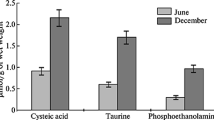Summary
-
1.
The activities of octopine dehydrogenase (ODH) and α-glycerophosphate dehydrogenase (GDH) were determined in several tissues ofPecten maximus. The ratios of ODH/GDH were 13 for the adductor muscle, 9 for the mantle and 3 for the digestive gland and the gill. Therefore, the main pathway for the glycolytic re-oxidation of NADH seemed to be via the formation of octopine.
-
2.
During burst activity the level of arginine phosphate in the adductor muscle declined concurently with an increase in arginine. Little octopine, however, accumulated until the animals were exhausted; the main increase in octopine concentration took place during the beginning of the subsequent rest period.
-
3.
It is concluded that inPecten maximus there is no “flare-up” of glycolysis during burst activity. Instead the increased demand for ATP is met by the breakdown of arginine phosphate. Octopine accumulates later, possibly due to a stimulation of glycolysis brought about by the activation of phosphofructokinase by AMP at low levels of arginine phosphate.
Similar content being viewed by others
Abbreviations
- GDH:
-
α-glycerophosphate dehydrogenase (E.C.1.1.1.8)
- ODH:
-
octopine dehydrogenase (E.C.1.5.1.11)
- LDH:
-
lactate dehydrogenase (E.C.1.1.1.27)
- DTT:
-
dithiothreitol
References
Fields, J.H.A., Baldwin, J., Hochachka, P.W.: On the role of octopine dehydrogenase in cephalopod mantle muscle metabolism. Canad. J. U Zool.54, 871–878 (1976)
Gäde, G.: Anaerobic metabolism of the common cockle,Cardium edule. I. The utilization of glycogen and accumulation of multiple end products. Arch. int. Physiol. Biochim.83, 879–886 (1975)
Gäde, G., Grieshaber, M.: Partial purification and properties of octopine dehydrogenase and the formation of octopine inAnodonta cygnea. J. comp. Physiol.102, 149–158 (1975a)
Gäde, G., Grieshaber, M.: A rapid and specific enzymatic method for the estimation of L-arginine. Analyt. Biochem.66, 393–399 (1975b)
Gäde, G., Zebe, E.: Über den Anaerobiosestoffwechsel von Molluskenmuskeln. J. comp. Physiol.85, 291–301 (1973)
Grieshaber, M., Gäde, G.: The biological role of octopine in the squid,Loligo vulgaris (Lamarck). J. comp. Physiol.108, 225–232 (1976)
Grieshaber, M., Gäde, G.: Energy supply and the formation of octopine in the adductor muscle of the scallop,Pecten jacobaeus (Lamarck). Comp. Biochem. Physiol.58B, 249–252 (1977)
Groves, W.E., Davis, F.C., Sells, B.H.: Spectrophotometric determination of microgram quantities of protein without nucleic acid interference. Analyt. Biochem.22, 195–210 (1968)
Hochachka, P.W.: Design of metabolic and enzymic machinery to fit lifestyle and environment. Biochem. Soc. Symp.41, 3–31 (1976)
Hochachka, P.W., Hartline, P.H., Fields, J.H.A.: Octopine as an end product of anaerobic glycolysis in the chamberedNautilus. Science195, 72–74 (1977)
Hiltz, D.F., Dyer, W.J.: Octopine in postmortem adductor muscle of the sea scallop (Placopecten maglellanicus). J. Fish. Res. Bd. Canada28, 869–874 (1971)
O'Doherty, P.J.A., Feltham, L.A.W.: Glycolysis and gluconeogenesis in the giant scallopPlacopecten magellanicus (Gmelin). Comp. Biochem. Physiol.38B, 543–551 (1971)
Thoai, N. van, Huc, C., Pho, D.B., Olomucki, A.: Octopine deshydrogenase. Purification et proprietes catalytiques. Biochim. biophys. Acta191, 46–57 (1969)
Thomas, G.E., Gruffydd, Ll.D.: The types of escape reactions elicited in the scallopPecten maximus by selected sea-star species. Mar. Biol.10, 87–93 (1971)
Storey, K.B.: Purification and properties of adductor muscle phosphofructokinase from the oyster,Crassostrea virginica. Europ. J. Biochem.70, 331–337 (1976)
Zammit, V.A., Newsholme, E.A.: The maximum activities of hexokinase, phosphorylase, phosphofructokinase, glycerol phosphate dehydrogenase, lactate dehydrogenase, octopine dehydrogenase, phosphoenolpyruvate carboxykinase, nucleoside diphosphatekinase, glutamate-oxaloacetate transaminase and arginine kinase in relation to carbohydrate utilization in muscles of marine invertebrates. Biochem. J.160, 447–462 (1976)
Zwaan, A. de: Anaerobic energy metabolism in bivalve molluses. Oceanogr. Mar. Biol. Ann. Rev.15, 103–187 (1977)
Zwaan, A. de, Kluytmans, J.H.F.M., Zandee, D.I.: Facultative anaerobiosis in molluses. Biochem. Soc. Symp.41, 133–168 (1976)
Author information
Authors and Affiliations
Rights and permissions
About this article
Cite this article
Gäde, G., Weeda, E. & Gabbott, P.A. Changes in the level of octopine during the escape responses of the scallop,Pecten maximus (L.). J Comp Physiol B 124, 121–127 (1978). https://doi.org/10.1007/BF00689172
Accepted:
Issue Date:
DOI: https://doi.org/10.1007/BF00689172



